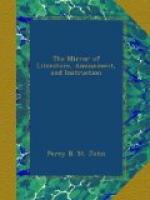Title: The Mirror of Literature, Amusement, and Instruction Volume 10, No. 274, Saturday, September 22, 1827
Author: Various
Release Date: February 27, 2004 [EBook #11330]
Language: English
Character set encoding: ASCII
*** Start of this project gutenberg EBOOK mirror of literature, no. 274 ***
Produced by Jonathan Ingram, Elaine Walker and the
Online Distributed
Proofreading Team.
THE MIRROR OF LITERATURE, AMUSEMENT, AND INSTRUCTION.
Vol. X, no. 274.] Saturday, September 22, 1827. [Price 2d.
ARCHITECTURAL ILLUSTRATIONS.
No. II.
[Illustration: The Temple church.]
The Temple Church,[1] London, was erected in the twelfth century; but among antiquarians considerable difference of opinion at various times prevailed as to who were the original builders of these round churches, which form the most striking and beautiful specimens of the architectural skill of our Anglo-Norman ancestors. In England there are four examples of round churches, almost in perfect preservation, namely, the church of St. Mary, Temple; St. Sepulchre, Northampton; St. Mary, Cambridge; and that of Little Maplestead, Essex. It was long thought that they were of Jewish origin; but through the ingenious and learned essays of Mr. Essex and of Mr. Britton, this erroneous notion has been entirely removed. Mr. Essex, in his Essay, observes, in support of his opinion, that “their Temple at Jerusalem was not of a circular form, neither was the Tabernacle of Moses; nor do we find the modern Jews affect that figure in building their synagogues. It has, however, been generally supposed that the round church at Cambridge, that at Northampton, and some others, were built for synagogues by the Jews while they were permitted to dwell in those places. But as no probable reason can be assigned for this supposition, and I think it is very certain that the Jews who were settled in Cambridge had their synagogue, and probably dwelled together in a part of the town now called the Jewry, so we may reasonably conclude the round churches we find in other parts of this kingdom were not built by the Jews for synagogues, whatever the places may be called in which they stand.”—It has been generally allowed by these and other writers on archaeology, that the primitive church of this form was that of the Holy Sepulchre at Jerusalem, and that the Temple Church at London was built by the Knights’ Templars, whose occupation was the protection of Christian pilgrims against the Saracens. It has been further urged by a correspondent (Charles Clarke, Esq. F.S.A.) in the first volume of Britton’s “Architectural Antiquities,” that two of the before-mentioned round churches, namely, Northampton and Cambridge, were in fact built by “affluent crusaders, in imitation of that of the Holy Sepulchre;” and in support of his opinion he cites several historical notices.




